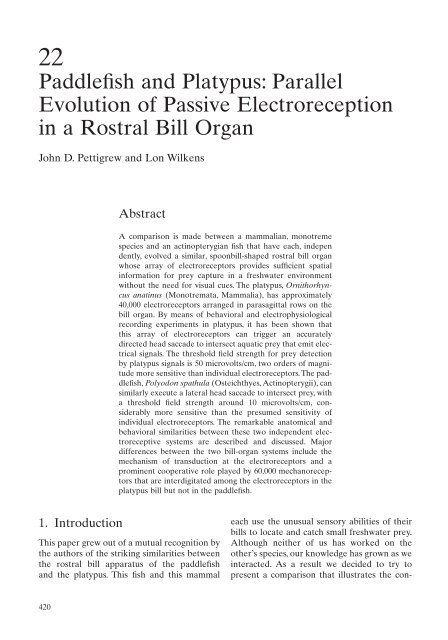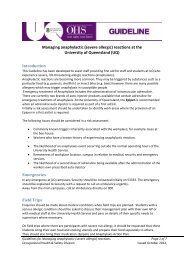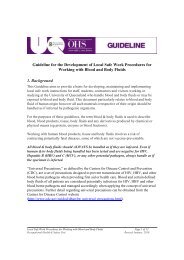Paddlefish and Platypus - University of Queensland
Paddlefish and Platypus - University of Queensland
Paddlefish and Platypus - University of Queensland
You also want an ePaper? Increase the reach of your titles
YUMPU automatically turns print PDFs into web optimized ePapers that Google loves.
SPA22 9/12/2002 4:11 PM Page 420<br />
22<br />
<strong>Paddlefish</strong> <strong>and</strong> <strong>Platypus</strong>: Parallel<br />
Evolution <strong>of</strong> Passive Electroreception<br />
in a Rostral Bill Organ<br />
John D. Pettigrew <strong>and</strong> Lon Wilkens<br />
1. Introduction<br />
420<br />
Abstract<br />
A comparison is made between a mammalian, monotreme<br />
species <strong>and</strong> an actinopterygian fish that have each, indepen<br />
dently, evolved a similar, spoonbill-shaped rostral bill organ<br />
whose array <strong>of</strong> electroreceptors provides sufficient spatial<br />
information for prey capture in a freshwater environment<br />
without the need for visual cues. The platypus, Ornithorhyncus<br />
anatinus (Monotremata, Mammalia), has approximately<br />
40,000 electroreceptors arranged in parasagittal rows on the<br />
bill organ. By means <strong>of</strong> behavioral <strong>and</strong> electrophysiological<br />
recording experiments in platypus, it has been shown that<br />
this array <strong>of</strong> electroreceptors can trigger an accurately<br />
directed head saccade to intersect aquatic prey that emit electrical<br />
signals. The threshold field strength for prey detection<br />
by platypus signals is 50 microvolts/cm, two orders <strong>of</strong> magnitude<br />
more sensitive than individual electroreceptors. The paddlefish,<br />
Polyodon spathula (Osteichthyes, Actinopterygii), can<br />
similarly execute a lateral head saccade to intersect prey, with<br />
a threshold field strength around 10 microvolts/cm, considerably<br />
more sensitive than the presumed sensitivity <strong>of</strong><br />
individual electroreceptors. The remarkable anatomical <strong>and</strong><br />
behavioral similarities between these two independent electroreceptive<br />
systems are described <strong>and</strong> discussed. Major<br />
differences between the two bill-organ systems include the<br />
mechanism <strong>of</strong> transduction at the electroreceptors <strong>and</strong> a<br />
prominent cooperative role played by 60,000 mechanoreceptors<br />
that are interdigitated among the electroreceptors in the<br />
platypus bill but not in the paddlefish.<br />
This paper grew out <strong>of</strong> a mutual recognition by<br />
the authors <strong>of</strong> the striking similarities between<br />
the rostral bill apparatus <strong>of</strong> the paddlefish<br />
<strong>and</strong> the platypus. This fish <strong>and</strong> this mammal<br />
each use the unusual sensory abilities <strong>of</strong> their<br />
bills to locate <strong>and</strong> catch small freshwater prey.<br />
Although neither <strong>of</strong> us has worked on the<br />
other’s species, our knowledge has grown as we<br />
interacted. As a result we decided to try to<br />
present a comparison that illustrates the con-
SPA22 9/12/2002 4:11 PM Page 421<br />
5<br />
22. <strong>Paddlefish</strong> <strong>and</strong> <strong>Platypus</strong>: Parallel Evolution 421<br />
vergent similarities <strong>and</strong> important differences<br />
between these extraordinary animals that have<br />
independently evolved the use <strong>of</strong> passive electroreception<br />
by an elaborate rostral bill organ<br />
to catch aquatic prey.<br />
We begin with a brief account <strong>of</strong> the biology<br />
<strong>of</strong> the two species <strong>and</strong> place them each in<br />
evolutionary context. We then give a detailed<br />
description <strong>of</strong> the electroreceptors <strong>and</strong> their<br />
arrangement in the bill organ in each species,<br />
with an account <strong>of</strong> the similarities <strong>and</strong> differences.We<br />
describe the lateral head saccade that<br />
is directed toward an electrically active prey in<br />
both species <strong>and</strong> show how this behavior has<br />
been used by investigators <strong>of</strong> both species to<br />
define the directionality <strong>and</strong> the threshold sensitivity<br />
<strong>of</strong> the electrosensory system. Since both<br />
species show far greater sensitivity to electrical<br />
stimuli at the whole animal level than at the<br />
level <strong>of</strong> individual receptors, we discuss this<br />
commonly observed discrepancy assuming<br />
that there is signal processing <strong>of</strong> the combined<br />
activity <strong>of</strong> large numbers <strong>of</strong> receptors. We show<br />
how both species avoid DC fields <strong>and</strong> finish<br />
with a discussion <strong>of</strong> the role <strong>of</strong> underwater<br />
mechanoreception as an adjunct to electroreception.<br />
This emerging bimodal viewpoint that<br />
considers waterborne mechanical stimuli arises<br />
from the extensive system <strong>of</strong> interdigitated<br />
electroreceptive <strong>and</strong> mechanoreceptive cortical<br />
neurons known in platypus, along with the<br />
mechanosensitivity <strong>of</strong> electrosensory ampullae<br />
in paddlefishes. Finally, we discuss the similarities<br />
<strong>and</strong> differences between the underwater<br />
prey detection systems <strong>of</strong> paddlefishes <strong>and</strong><br />
platypus in the context <strong>of</strong> conservation issues.<br />
2. Biographical Sketches <strong>of</strong><br />
the Animals<br />
2.1. <strong>Paddlefish</strong>es<br />
The paddlefish, Polyodon spathula, is among<br />
the most primitive <strong>of</strong> bony-finned fishes<br />
(Osteichthyes, Actinopterygii), <strong>and</strong> together<br />
with sturgeon comprises an order <strong>of</strong> secondarily<br />
cartilaginous fishes, the Acipenseriformes.<br />
The North American paddlefish is one <strong>of</strong> only<br />
two extant species in the family Polyodontidae<br />
whose origins extend back into the Cretaceous<br />
period, over 100 mya; the sister species Psephurus<br />
is native to China. <strong>Paddlefish</strong>es once ranged<br />
throughout the turbid midwestern rivers <strong>of</strong> the<br />
United States.<br />
By virtue <strong>of</strong> their elongated rostrum (i.e., bill<br />
or paddle), paddlefishes are unique among the<br />
approximately 25,000 species <strong>of</strong> living fishes.<br />
Unlike other fishes with long noses <strong>and</strong> jaws,<br />
the paddlefish rostrum is an elongation <strong>of</strong> its<br />
cranium. In platypus, the upper bill is maxillary<br />
<strong>and</strong> is fused to the cranium. The prominent<br />
rostrum comprises one-third the length <strong>of</strong> the<br />
fish, even more in small fishes, <strong>and</strong> is responsible<br />
for the common functional misrepresentation<br />
indicated by the synonymic names<br />
“spoonbill cat” <strong>and</strong> “shovelnose cat.” <strong>Paddlefish</strong>es<br />
also are notable for their large size,<br />
once known to reach 75 kg <strong>and</strong> 2 m, which they<br />
achieve by feeding on a rich zooplankton<br />
resource at the base <strong>of</strong> the food chain. As filter<br />
feeders, <strong>and</strong> one <strong>of</strong> the largest riverine species<br />
<strong>of</strong> fishes, they are the ecological equivalent in<br />
freshwater <strong>of</strong> baleen whales <strong>and</strong> large filterfeeding<br />
marine fishes such as the whale <strong>and</strong><br />
basking shark.<br />
Only recently (Wilkens et al., 1997) has the<br />
evolutionary significance <strong>of</strong> the paddle been<br />
correlated with the fish’s planktonic diet <strong>and</strong><br />
its muddy, nonvisual environment. In feeding<br />
experiments, small paddlefishes readily capture<br />
tiny plankton (Daphnia) without benefit <strong>of</strong><br />
their visual, chemical, or hydrodynamic senses<br />
(Wilkens et al., 2001). This suggests the existence<br />
<strong>of</strong> an alternate sensory mechanism.<br />
Like the platypus bill, the paddlefish rostrum is<br />
covered by an extensive array <strong>of</strong> electroreceptors,<br />
here the ampullae <strong>of</strong> Lorenzini (Jørgensen<br />
et al., 1972).Thus, the rostrum <strong>and</strong> its ampullary<br />
electroreceptors comprise the functional equivalent<br />
<strong>of</strong> an antenna, a sensory device with<br />
sufficient sensitivity to detect the electric fields<br />
<strong>of</strong> their planktonic prey (Wilkens et al., 1997;<br />
Russell et al., 1999).<br />
While we have established the role <strong>of</strong> the<br />
electroreception in planktivorous feeding in<br />
small juvenile paddlefishes, the sensory mechanisms<br />
used by large adult fishes have not been<br />
determined. Unlike juveniles that feed selectively<br />
by capturing individual plankton, large
SPA22 9/12/2002 4:11 PM Page 422<br />
422 J.D. Pettigrew <strong>and</strong> L. Wilkens<br />
fishes feed nonselectively by sieving plankton<br />
from the water using comb-like gill rakers not<br />
fully developed until fishes reach 22–23 cm in<br />
length (Rosen <strong>and</strong> Hales, 1981). However, large<br />
healthy fishes occasionally are found missing<br />
their paddle, presumably the result <strong>of</strong> mutilation<br />
by boat propellers. Since juvenile fishes<br />
have not been observed in the wild except with<br />
their paddles intact, it is presumed that the electrosensory<br />
system is an adaptation primarily<br />
benefiting young paddlefishes when feeding<br />
selectively (i.e., capturing plankton one at a<br />
time).<br />
2.2. <strong>Platypus</strong><br />
The platypus, Ornithorhyncus anatinus, is one<br />
<strong>of</strong> three living species <strong>of</strong> monotremes (egglaying<br />
mammals with a single opening, the<br />
cloaca, for both excretory <strong>and</strong> reproductive<br />
functions) (Griffith, 1978). The only other<br />
two extant monotremes (Tachyglossus aculeatus<br />
<strong>and</strong> Zaglossus brujnii) are l<strong>and</strong>-dwelling, spinecovered<br />
echidnas that arose relatively recently<br />
(20–30 myr) from an ancient platypus lineage<br />
that can be traced back more than 100myr<br />
(Pettigrew, 1999). The first specimen <strong>of</strong> a platypus<br />
to reach the West was believed at first to be<br />
a fake, as it was thought that the duck-like bill<br />
had been cunningly stitched to the luxuriant fur<br />
(Griffith, 1998). <strong>Platypus</strong> live in a long burrow<br />
with an entrance close to, or below, water level.<br />
The tunnel can be a tight fit, particularly in the<br />
breeding female’s burrow, which is much longer<br />
than usual. The length <strong>and</strong> fit ensure that the<br />
platypus is dry by the time it reaches the nest<br />
area at the end, even when there is a high frequency<br />
<strong>of</strong> hunting sorties to the water that<br />
would tend to wet the tunnel, as for the breeding<br />
female. Eyes, nostrils, <strong>and</strong> ears are all closed<br />
underwater <strong>and</strong> prey are located by a combination<br />
<strong>of</strong> electroreception <strong>and</strong> mechanoreception<br />
(see below). Prey are benthic <strong>and</strong> include<br />
crustaceans, insect larvae, worms, <strong>and</strong> fishes.<br />
On an average foraging trip, which is usually at<br />
night, a platypus may consume half its weight<br />
in prey, in total darkness. Juveniles may hunt<br />
in daylight as well, perhaps because they are<br />
smaller, with a greater metabolic rate, <strong>and</strong>/or<br />
because they are less skillful at finding prey <strong>and</strong><br />
therefore need to spend more time in this activity<br />
(J.D. Pettigrew, unpublished). An extensive<br />
series <strong>of</strong> behavioral observations has clarified<br />
how platypus use electroreception, perhaps in<br />
conjunction with mechanoreception, to locate<br />
aquatic prey in three dimensions (Manger <strong>and</strong><br />
Pettigrew, 1995; Manger et al., 1996; Pettigrew<br />
et al., 1998). The 40,000 electroreceptors on<br />
the bill form a directional antenna that allows<br />
instantaneous determination <strong>of</strong> the azimuth<br />
<strong>and</strong> elevation <strong>of</strong> a prey’s electrical discharge so<br />
that a head saccade can be directed accurately<br />
toward it. By combining mechanosensory <strong>and</strong><br />
electrosensory inputs together in an extraordinary<br />
cortical structure resembling the celebrated<br />
ocular dominance columns <strong>of</strong> primates,<br />
the platypus may be able to fix the third coordinate<br />
<strong>of</strong> its prey, distance, from the time<strong>of</strong>-arrival<br />
difference between the electrical<br />
signal <strong>and</strong> its later mechanical wave produced<br />
by prey.<br />
Early development after hatching takes<br />
place in the burrow, with the female providing<br />
milk that is secreted onto her fur rather than<br />
from a nipple (Griffiths, 1978). Electroreceptors<br />
develop on the bill at this very early stage,<br />
before mechanoreceptors, suggesting that<br />
electroreceptors may have a functional role,<br />
perhaps in suckling, before the juvenile enters<br />
the water for the first time (Manger et al., 1999).<br />
3. Arrangement <strong>of</strong><br />
Electroreceptors on<br />
Rostrum <strong>and</strong> Bill<br />
3.1. <strong>Paddlefish</strong> Ampullae<br />
The paddlefish skin covering the upper <strong>and</strong><br />
lower surfaces <strong>of</strong> the paddle, the head, opercular<br />
flaps, <strong>and</strong> lower jaw is penetrated by numerous<br />
pores, 65–140 mm in diameter <strong>and</strong> just<br />
visible to the naked eye. An 80-cm fish was estimated<br />
to have 57,365 pores (Kistler, 1906), with<br />
numbers as high as 75,000 per fish (Nachtrieb,<br />
1910). Pores occur in clusters <strong>of</strong> 5–25 that are<br />
more numerous near the lateral margins <strong>of</strong> the<br />
paddle, but absent from an 8–10-mm wide strip<br />
along the midline <strong>of</strong> both upper <strong>and</strong> lower<br />
surfaces.
SPA22 9/12/2002 4:11 PM Page 423<br />
22. <strong>Paddlefish</strong> <strong>and</strong> <strong>Platypus</strong>: Parallel Evolution 423<br />
Each pore opens into the pear-shaped lumen<br />
<strong>of</strong> an ampullary organ 100–250 mm deep. The<br />
lower half <strong>of</strong> the ampulla is lined by a sensory<br />
epithelium <strong>of</strong> ciliated receptors <strong>and</strong> supporting<br />
cells (Jørgensen et al., 1972). Tight junctions<br />
near the luminar surface join the receptor<br />
<strong>and</strong> supporting cells. The receptor cells form<br />
synapses with the nerve endings <strong>of</strong> primary<br />
afferent neurons that converge into anterior<br />
lateral line nerves that travel to the brain. Each<br />
receptor synapses with several nerve terminals<br />
<strong>and</strong> each primary afferent innervates numerous<br />
receptor cells. Although characterized early<br />
on as sensory organs (Kistler, 1906), Nachtrieb<br />
(1910) argued vigorously that the ampullae<br />
were secretory organs owing to the gelatinous<br />
secretions inside the pits. Their electrosensory<br />
function as ampullae <strong>of</strong> Lorenzini was established<br />
unequivocally by the anatomical study <strong>of</strong><br />
Jørgensen et al. (1972).<br />
3.2. <strong>Platypus</strong> Electroreceptors<br />
Electroreceptors are readily recognized in<br />
low-power micrographs (even in obliquely lit<br />
Figure 22.1. Electroreceptor arrays in platypus <strong>and</strong><br />
paddlefishes. Views <strong>of</strong> upper <strong>and</strong> lower surfaces <strong>of</strong><br />
the rostral bill organ <strong>of</strong> each species (there are also<br />
many electroreceptors on the inner surfaces <strong>of</strong> the<br />
upper <strong>and</strong> lower m<strong>and</strong>ibles, not shown). Approximately<br />
40,000 electroreceptors in platypus (mucous<br />
naked-eye views) because <strong>of</strong> the pores that<br />
penetrate the thick epidermis to enable the necessary<br />
flow <strong>of</strong> current to the nerve endings.<br />
There are two kinds <strong>of</strong> electroreceptor that<br />
can be easily recognized in low-power micrographs<br />
<strong>and</strong> SEM views <strong>of</strong> the bill skin because<br />
<strong>of</strong> differences in the size <strong>and</strong> shape <strong>of</strong> the<br />
flower-petal-like arrangement <strong>of</strong> keratin that<br />
surrounds the pore <strong>and</strong> that opens when the bill<br />
is immersed (Manger et al., 1996). These two<br />
kinds <strong>of</strong> electroreceptors are associated separately<br />
with serous <strong>and</strong> mucous gl<strong>and</strong>s. The<br />
role <strong>of</strong> the serous gl<strong>and</strong> electroreceptors is still<br />
obscure <strong>and</strong> they will not be considered further<br />
here, except to note that they have a lower<br />
density <strong>and</strong> completely different distribution<br />
on the bill from the mucous gl<strong>and</strong> electroreceptors<br />
<strong>and</strong> have been speculated to be<br />
involved in near-field or DC detection (Manger<br />
<strong>and</strong> Pettigrew, 1997). Mucous gl<strong>and</strong> electroreceptors<br />
are much more common, with a total <strong>of</strong><br />
40,000 distributed over all the epidermal surfaces<br />
<strong>of</strong> the bill, with a marked concentration<br />
at the edges <strong>and</strong> a striking parasagittal stripe<br />
arrangement on the dorsum <strong>of</strong> the bill (Fig. 22.1).<br />
gl<strong>and</strong> type) are arrayed in parasagittal rows, with<br />
a prominent raphe lacking in receptors along<br />
the midline. About 50,000–60,000 electroreceptors<br />
in paddlefishes (ampullae <strong>of</strong> Lorenzini type) are<br />
arranged in clusters with a prominent midline raphe<br />
where afferent nerve fibers travel.<br />
4
SPA22 9/12/2002 4:11 PM Page 424<br />
424 J.D. Pettigrew <strong>and</strong> L. Wilkens<br />
As their name suggests, mucous gl<strong>and</strong> electroreceptors<br />
are modified mucous gl<strong>and</strong>s. The<br />
base <strong>of</strong> the gl<strong>and</strong> duct is penetrated radially by<br />
about one dozen free nerve endings, originating<br />
from a daisy-chain-like arrangement <strong>of</strong> lateral<br />
connections between nerve terminals where<br />
it is suspected that there are gap junctions<br />
that would act to reduce noise (Manger <strong>and</strong><br />
Pettigrew, 1998; Pettigrew et al., 1999). The free<br />
nerve endings pass through a barrier that is<br />
inferred to have very high impedance to lie in<br />
electrical contact with the medium at the center<br />
<strong>of</strong> the gl<strong>and</strong> duct without any associated epithelial<br />
cell specialization (Fig. 22.2). This arrangement<br />
contrasts strongly with electroreceptors<br />
in the paddlefish where epithelial receptor cells<br />
Figure 22.2. (A) Arrangement <strong>of</strong> free nerve endings<br />
in platypus mucous gl<strong>and</strong> electroreceptor. Up to 12<br />
myelinated fibers lose their myelin sheaths on entering<br />
the base <strong>of</strong> the gl<strong>and</strong> duct. Lateral extensions <strong>of</strong><br />
the free nerve endings originate from bulb-shaped<br />
expansions filled with mitochondria. The lateral<br />
extension joins all participating fibers in a daisy chain<br />
around the base <strong>of</strong> the duct, presumably to facilitate<br />
some form <strong>of</strong> common-mode rejection <strong>of</strong> electrical<br />
signals that are not shared in all terminals. A terminal<br />
filament pierces the electron-dense zone around<br />
provide the transducing interface between<br />
the nerve ending <strong>and</strong> electric current in the<br />
aqueous environment.<br />
The parasagittal stripe arrangement suggested<br />
to investigators that there might be<br />
integration between the output <strong>of</strong> different<br />
electroreceptors that lay with a parasagittal<br />
arrangement to each other. This was tested<br />
electrophysiologically <strong>and</strong> behaviorally. Receptive<br />
fields <strong>of</strong> electroreceptors recorded at the<br />
level <strong>of</strong> the neocortex show elongations that<br />
are roughly parallel to the sagittal axis, in<br />
accord with this suggestion (Krubitzer et al.,<br />
1991). Moreover, when the sensitivity <strong>of</strong> the<br />
whole bill is measured using the head saccade<br />
paradigm, the axis <strong>of</strong> maximal sensitivity is<br />
the duct to lie free in the mucous-filled ambient.<br />
Note there there is no associated epithelial cell<br />
involved in electrical transduction at the terminal<br />
in the platypus, as there is in the paddlefish. (B)<br />
Generalized ampullary electroreceptors, as found in<br />
the paddlefish rostrum. Note that the afferent nerve<br />
endings terminate on ciliated sensory epithelial cells<br />
that are responsible for transduction, in contrast to<br />
the free nerve endings seen in the mammalian<br />
electroreceptor.
SPA22 9/12/2002 4:11 PM Page 425<br />
22. <strong>Paddlefish</strong> <strong>and</strong> <strong>Platypus</strong>: Parallel Evolution 425<br />
found lateral, slightly forward <strong>and</strong> down from<br />
an axis at right angle to the lateral edge <strong>of</strong> the<br />
bill (Manger <strong>and</strong> Pettigrew, 1997). Given the<br />
complex, slightly curved shape <strong>of</strong> the bill, this is<br />
what would be expected if there were a general<br />
principle <strong>of</strong> integration that favored electroreceptors<br />
along the sagittal axis.<br />
3.3. Comparison<br />
The paddlefish lacks the tell-tale parasagittal<br />
stripe arrangement <strong>of</strong> electroreceptors that<br />
may reveal the underlying strategy by which the<br />
platypus integrates information from such a<br />
large number <strong>of</strong> receptors in its central nervous<br />
system. Yet, a parasagittal axis <strong>of</strong> integration is<br />
suggested in the paddlefish too, by the fact<br />
that paddlefish electroreceptors are distributed<br />
preferentially along the rostrum edges. A<br />
parasagittal organization is also suggested by<br />
the preference for lateral strikes that indicates<br />
that the paddlefish, like the platypus, is most<br />
sensitive to signals that emanate laterally,<br />
rather than frontally or from any other<br />
direction.<br />
The fine structure <strong>of</strong> the electroreceptors<br />
in the two taxa, as might be expected from<br />
their separate phylogenetic derivations, is completely<br />
different. The trigeminal nerve endings<br />
<strong>of</strong> the platypus lack any associated epithelial<br />
cell specializations, instead showing an elaborate<br />
structure where a dozen or more nerve<br />
terminals are linked circumferentially around<br />
the pore, into which penetrate a dozen or more<br />
free nerve endings. This structure is unstudied<br />
physiologically <strong>and</strong> even microscopical information<br />
is scanty, but it seems very likely that<br />
the terminals are all linked by gap junctions<br />
that would form a pool <strong>of</strong> receptors that could<br />
act to reduce electrical noise from one pore, just<br />
as coupled pools <strong>of</strong> photoreceptors use simultaneity<br />
to reduce noise in low light levels where<br />
the signal-to-noise ratio is low. Under normal<br />
circumstances for the electroreceptive systems<br />
there is a high noise level, so it is easy to<br />
imagine a useful role played by a coupled pool<br />
<strong>of</strong> detectors that were all signaling the field<br />
strength in the same pore <strong>and</strong> performing some<br />
kind <strong>of</strong> common mode rejection operation. The<br />
absence <strong>of</strong> an epithelial cell to provide a recep-<br />
tor potential <strong>and</strong> to transduce the electrical<br />
signal could explain why platypus electrosensitivity<br />
is relatively low compared with the<br />
paddlefish, whose electroreceptors involve an<br />
epithelial receptor cell whose physiology is<br />
well-known from extensive studies <strong>of</strong> other<br />
passive electric fishes <strong>and</strong> which have lower<br />
thresholds than the platypus (Wilkens et al.,<br />
1997).<br />
4. Lateral Head Saccade<br />
4.1. <strong>Paddlefish</strong>es<br />
The swimming undulations <strong>of</strong> the paddlefish<br />
trunk impart a lateral oscillating motion to the<br />
rostrum, with the cranium acting as the fulcrum.<br />
<strong>Paddlefish</strong>es are ram ventilators (Burggren <strong>and</strong><br />
Bemis, 1992), so swimming is continuous. This<br />
saccade-like motion may serve to enhance prey<br />
detection by increasing the width <strong>of</strong> the electrical<br />
scan field. Rapid lateral saccades, a<br />
yaw-like motion, also characterize the motion<br />
sequences involved in prey capture, as dictated<br />
by the broad, flat shape <strong>of</strong> the rostrum. For<br />
example, as plankton drift by lateral to the<br />
rostrum the paddlefish makes sudden flexions<br />
that jerk the head <strong>and</strong> rostrum toward the<br />
prey as the mouth begins to open (Fig. 22.3).<br />
From the moment <strong>of</strong> detection the strike <strong>and</strong><br />
gulp sequence takes 150–200 ms. For plankton<br />
encountered above or below the rostrum, a<br />
more complex motion sequence ensues. The<br />
fish initially rolls about its long axis, up to 90°<br />
or more, followed by the same lateral saccade,<br />
now directed in a vertical or oblique plane.<br />
Thus, each rapid strike, regardless <strong>of</strong> prey location,<br />
results in a slicing motion <strong>of</strong> the rostrum<br />
through the water that affords the least resistance.<br />
Plankton are captured by these accurate<br />
feeding strikes, up to 8–9 cm from the rostrum,<br />
some <strong>of</strong> which involve acrobatic combinations<br />
<strong>of</strong> rolls, lateral saccades, <strong>and</strong> complete turns if<br />
the plankton drifts past the mouth.<br />
4.2 <strong>Platypus</strong><br />
The platypus lateral head saccade is elicited<br />
reflexly by a brief electrical stimulus. If the
SPA22 9/12/2002 4:11 PM Page 426<br />
426 J.D. Pettigrew <strong>and</strong> L. Wilkens<br />
Figure 22.3. Head saccades to electrical stimuli by<br />
platypus <strong>and</strong> paddlefishes. Stationary platypus: The<br />
two video frames are taken 60 msec apart, with the<br />
platypus at rest in a tank (see Manger <strong>and</strong> Pettigrew,<br />
1995 for more details). The electrical stimulus was<br />
a square-wave pulse from a unipolar electrode (E)<br />
that produced a field at the near side <strong>of</strong> the bill <strong>of</strong><br />
around 200 mV/cm. The resulting saccade toward<br />
the stimulus had a small amplitude in this habituated<br />
platypus (saccades during patrolling <strong>and</strong> prey<br />
capture are larger), but can readily be seen by<br />
referring the right bill edge to the angled exhaust<br />
pipe on the left side <strong>of</strong> the figure <strong>and</strong> by reference<br />
to the dotted outline, which shows the position <strong>of</strong><br />
the bill’s left edge at 0 msec. In a swimming platypus,<br />
a saccade like this will act to reset the swimming<br />
direction behind the head so that the platypus<br />
changes direction <strong>and</strong> swims toward the prey.<br />
Saccades to electrical stimuli can follow to 15 Hz.<br />
platypus is swimming, the head saccade causes<br />
resetting <strong>of</strong> the swimming rhythm <strong>of</strong> the body<br />
behind the head. In this way, the head saccade<br />
causes the platypus to swim toward the source<br />
<strong>of</strong> the stimulus (videotape in Manger, 1998).<br />
The head saccade is directed accurately toward<br />
the direction <strong>of</strong> the electrical source, whether<br />
this is above, below, or lateral to the bill,<br />
although it is much more sensitive to sources<br />
that emanate laterally, forward, <strong>and</strong> down,<br />
along the axis <strong>of</strong> the electroreceptive system. In<br />
captivity, platypus are intensely curious about<br />
gentle electrical stimuli, which are explored <strong>and</strong><br />
mouthed.This exploratory behavior soon habituates,<br />
but the head saccade remains, with the<br />
(A fast sequence <strong>of</strong> saccades can be viewed at<br />
www.uq.eud.au/nuq/jack/platypus.html.) Swimming<br />
paddlefish: The prey item, Daphnia, is shown as a<br />
white highlight. The electrical discharge (no other<br />
sensory cues are available to the fish in this darkened<br />
tank illuminated with infrared) triggers a lateral <strong>and</strong><br />
slightly downward-directed saccade, along with jaw<br />
opening, that will permit the paddlefish to swallow<br />
the prey. In both species, the spatial information that<br />
guides the accurate directionality <strong>of</strong> the saccade has<br />
been gathered almost instantaneously from the electrical<br />
field generated by the stimulus, rather than<br />
being the result <strong>of</strong> an algorithm to track the field<br />
strength as the animal moves through it (e.g., the<br />
Kalmijn algorithm). Instantaneous determination<br />
thereby implies sophisticated signal processing by<br />
the spatial array <strong>of</strong> electroreceptors on the bill.<br />
Scale = 1cm in both cases.<br />
platypus unable to suppress it after thous<strong>and</strong>s<br />
<strong>of</strong> trials. The head saccade behavior can then<br />
form a useful basis for the exploration <strong>of</strong> the<br />
parameters <strong>of</strong> electroreception, such as threshold<br />
<strong>and</strong> directionality.<br />
4.3 Comparison<br />
Given the similar orientation <strong>of</strong> the rostrum<br />
<strong>and</strong> bill, it is perhaps not surprising that both<br />
paddlefish <strong>and</strong> platypus have evolved a shortlatency<br />
head saccade with the same lateral<br />
direction to move through the water toward<br />
prey with least resistance (Fig. 22.4). Since both<br />
rostrum <strong>and</strong> bill have similar shapes <strong>and</strong> have
SPA22 9/12/2002 4:11 PM Page 427<br />
22. <strong>Paddlefish</strong> <strong>and</strong> <strong>Platypus</strong>: Parallel Evolution 427<br />
the greatest concentration <strong>of</strong> electroreceptors<br />
along the edges, both would be expected to<br />
have axes <strong>of</strong> greatest sensitivity to electrical<br />
stimuli that originate laterally, rather than<br />
frontally or along some other axis, as has been<br />
shown for the platypus <strong>and</strong> as seems very likely<br />
for the paddlefish, too. The similarities in prey<br />
capture style can thus be attributed to several<br />
Figure 22.4. Comparison <strong>of</strong> platypus with paddlefish<br />
to show the similarity <strong>of</strong> the paddle-shaped bill<br />
organ <strong>and</strong> rostrum respectively. (A) The bill organ <strong>of</strong><br />
the platypus (<strong>and</strong> one <strong>of</strong> its prey, the yabbie, Cherax<br />
spp.). About 40,000 electroreceptors <strong>and</strong> 60,000<br />
mechanoreceptors form a sensory array that enables<br />
the capture <strong>of</strong> small benthic invertebrates, as well as<br />
some vertebrates such as fishes, without any assistance<br />
from vision, hearing, or olfaction. Note the<br />
numerous pits formed by the opening <strong>of</strong> the mucous<br />
factors that have combined to ensure that an<br />
explosive strike by the bill has shortest latency<br />
when the bill orientation, neck muscle arrangement,<br />
<strong>and</strong> greatest sensitivity <strong>of</strong> the electroreceptor<br />
system are all optimal for a laterally<br />
directed saccade.<br />
It is worth considering the underlying neural<br />
basis for a well-localized strike <strong>of</strong> this kind.<br />
gl<strong>and</strong> electroreceptors on the bill; these pits are<br />
barely visible where they are in sharper focus on<br />
the more proximal region <strong>of</strong> the bill, near the eye.<br />
(B) Young paddlefish attacking the dipole wires as if<br />
trying to capture plankton: Its rostrum is innervated<br />
by about 60,000 ampullary electroreceptors that<br />
enable the capture, using the prey’s electrical discharge,<br />
<strong>of</strong> free-swimming invertebrates such as<br />
Daphnia.
SPA22 9/12/2002 4:11 PM Page 428<br />
428 J.D. Pettigrew <strong>and</strong> L. Wilkens<br />
Many passive electric fishes appear to use<br />
Kalmijn’s “approach algorithm” to localize a<br />
dipole, but note that this cannot be true for the<br />
lateral head saccades <strong>of</strong> platypus <strong>and</strong> paddlefish,<br />
which are instantaneously directional<br />
<strong>and</strong> do not require successive approximation<br />
toward the target. Both platypus <strong>and</strong> paddlefish<br />
must “know” at very short latency, the shape <strong>of</strong><br />
the electric field generated by the prey in order<br />
to localize it so accurately <strong>and</strong> quickly. Such a<br />
calculation would involve the simultaneous<br />
reporting <strong>of</strong> field strength from a large number<br />
<strong>of</strong> the electroreceptors distributed over the<br />
rostrum or bill. This calculation would be aided<br />
by the bill shape, whose flattened lateral dimension<br />
<strong>and</strong> high density <strong>of</strong> electroreceptors would<br />
help ensure that changes in field strength<br />
would be most detectable along just the axis<br />
most relevant to localizing the prey for a<br />
strike. The elaborate neural mechanisms that<br />
would provide a platypus with a “map” <strong>of</strong> field<br />
strength over the surface <strong>of</strong> the bill have been<br />
well-described (Krubitzer et al., 1996; Calford<br />
et al., 1998). We can only assume that there<br />
are similar mechanisms that subserve the high<br />
density <strong>of</strong> electroreceptors on the similarly<br />
shaped rostrum <strong>of</strong> the paddlefish.<br />
5. Sensitivity<br />
5.1. <strong>Paddlefish</strong>es<br />
A lateral head strike, like the platypus’s head<br />
saccade, can be elicited from a paddlefish by a<br />
Daphnia at 10 cm. Since Daphnia produce field<br />
strengths <strong>of</strong> around 1 mV/cm, the paddlefish’s<br />
sensitivity is around 10 mV/cm, assuming a<br />
cubic fall-<strong>of</strong>f in field strength from this circumscribed,<br />
tiny prey. Since a directed response<br />
would require the coordinated activity <strong>of</strong> many<br />
electroreceptors, we can assume that not all<br />
receptors will be stimulated with strengths as<br />
great as 10 mV/cm <strong>and</strong> that signal detection<br />
algorithms will be applied by the paddlefish<br />
nervous system to look at activation across<br />
the array. Little is known about the details<br />
<strong>of</strong> this process, which is responsible for the<br />
much greater sensitivity <strong>of</strong> the whole animal<br />
when compared with sensitivity <strong>of</strong> individual<br />
electroreceptors. The electrical threshold for<br />
detecting <strong>and</strong> avoiding a DC field, such as<br />
created by a metallic object underwater, is<br />
much smaller, around 0.5 nV/cm in the paddlefish.<br />
The difference between these two thresholds<br />
is not explained, but could derive from the<br />
punctate nature <strong>of</strong> stimulation with Daphnia,<br />
where one would expect different receptors in<br />
the array to be subject to markedly different<br />
stimulus strength according to their position in<br />
relation to the Daphnia, compared with the<br />
more uniform pattern <strong>of</strong> stimulation that one<br />
would expect from a large, submerged metal<br />
object.<br />
5.2. <strong>Platypus</strong><br />
The most extensive studies <strong>of</strong> the electrosensory<br />
threshold <strong>of</strong> platypus were conducted<br />
using the lateral head saccade to a brief electrical<br />
stimulus (Manger <strong>and</strong> Pettigrew, 1998).<br />
If one adopts a one-to-one criterion for a<br />
head saccade following an electrical pulse, the<br />
threshold field strength is 50 mV/cm. This is<br />
20–50¥ less than the 1–2-mV/cm threshold<br />
established for single nerve fibers emanating<br />
from the electroreceptors themselves (Gregory<br />
et al., 1987a,b; 1988), the difference being<br />
accountable in terms <strong>of</strong> signal detection in the<br />
massively enlarged bill-representation <strong>of</strong> the<br />
platypus brain. Little is known about the signal<br />
detection algorithms that are used by the platypus<br />
brain, but some idea <strong>of</strong> their sophistication<br />
can be gained by a study <strong>of</strong> time averaging that<br />
showed that a platypus can act as a computer<br />
<strong>of</strong> average transients <strong>and</strong> lower its threshold<br />
if the same electrical stimulus is presented<br />
repeatedly! (Farrebr<strong>and</strong>t et al., 1999). This<br />
phenomenon will be familiar to readers who<br />
have wondered whether their name may have<br />
been called in a noisy environment, only to<br />
have their suspicion confirmed when the call<br />
is repeated. If the same electrical stimulus is<br />
repeated many times, the platypus threshold<br />
falls to a low <strong>of</strong> 10 mV/cm.<br />
The electrical threshold for detecting a DC<br />
source in platypus is not known, but from<br />
experiments with avoidance <strong>of</strong> metal objects<br />
we can assume that it is equal to, or less than,<br />
the threshold for a lateral head saccade.
SPA22 9/12/2002 4:11 PM Page 429<br />
1<br />
22. <strong>Paddlefish</strong> <strong>and</strong> <strong>Platypus</strong>: Parallel Evolution 429<br />
5.3. Comparison<br />
Both taxa have remarkable similarity in the<br />
sensitivity <strong>of</strong> the strike to electrical stimuli<br />
generated by prey, with the paddlefish system<br />
having an order <strong>of</strong> magnitude greater sensitivity<br />
than the platypus, at 10 mV/cm. To strike at<br />
a Daphnia, the platypus would have to be 3 cm<br />
away, rather than the 10 cm at which a paddlefish<br />
can successfully strike its favorite prey. One<br />
would imagine that caddis-fly larvae, a favored<br />
platypus prey item with size <strong>and</strong> field strength<br />
in the range <strong>of</strong> Daphnia, would permit the<br />
closer approach needed by the platypus to elicit<br />
a strike. On the other h<strong>and</strong>, more mobile platypus<br />
prey that would require active pursuit<br />
<strong>and</strong> more distant detection, such as Macrobrachium<br />
<strong>and</strong> Ateya, have long bodies <strong>and</strong> strong<br />
fields compared with Daphnia <strong>and</strong> would be<br />
detectable by the platypus at 10 cm (Pettigrew<br />
et al., 1999). Whether these larger crustaceans<br />
would also be attractive to the paddlefish, as<br />
this comparison suggests, is an unanswered<br />
question.<br />
In contrast to the systematic study <strong>of</strong> paddlefish<br />
avoidance <strong>of</strong> DC fields (Wilkens et al.,<br />
2000), there is no detailed study <strong>of</strong> the threshold<br />
for avoidance <strong>of</strong> DC fields by platypus. The<br />
greatly enhanced sensitivity <strong>of</strong> the paddlefish to<br />
DC fields raises the possibility that platypus<br />
may also be more sensitive to such fields than<br />
they are to AC fields such as those generated<br />
by prey, but the available data are agnostic on<br />
this point. It has been suggested that the less<br />
common serous gl<strong>and</strong> electroreceptors mediate<br />
DC detection in platypus. This separation <strong>of</strong><br />
function certainly echoes the dramatic difference<br />
in threshold between the detection <strong>of</strong> AC<br />
<strong>and</strong> DC in paddlefishes. For these reasons it<br />
might be pr<strong>of</strong>itable to look for a segregation <strong>of</strong><br />
both structure <strong>and</strong> function in paddlefishes<br />
<strong>and</strong> to undertake a more extensive study <strong>of</strong> DC<br />
thresholds in platypus.<br />
6. Role <strong>of</strong> Mechanoreception<br />
6.1. <strong>Paddlefish</strong>es<br />
Any mechanical disturbance created by a<br />
Daphnia at the rostrum <strong>of</strong> the paddlefish when<br />
it is located 10 cm away is presumably very<br />
small <strong>and</strong> unlikely to be detectable compared<br />
with the threshold electrical stimulus <strong>of</strong> 10<br />
mV/cm at this distance. For this reason, the<br />
mechanosensory properties <strong>of</strong> the ampullary<br />
receptors are not likely to play as important a<br />
role in detection <strong>of</strong> Daphnia as their electrosensory<br />
properties. Nevertheless, this aspect<br />
may be worthy <strong>of</strong> further investigation, both<br />
because the ampullary receptors do have<br />
acute mechanical sensitivity <strong>and</strong> because the<br />
near-field mechanical stimulation produced by<br />
Daphnia may cause surprises in the same way<br />
that the mechanical stimulation provided by<br />
platypus prey had unexpected effects on the<br />
sensory system for prey detection in the bill.<br />
6.2. <strong>Platypus</strong><br />
There are 60,000 mechanoreceptors in the<br />
platypus bill, interspersed with the 40,000<br />
electroreceptors. It was generally assumed that<br />
these mechanoreceptors were not involved in<br />
the electroreceptive detection <strong>of</strong> aquatic prey,<br />
but rather in processing the direct contact with<br />
prey that had been captured. That view has<br />
been overturned by a number <strong>of</strong> new observations:<br />
(1) When the bill is out <strong>of</strong> the water,<br />
the mechanoreceptors, “pushrods,” are tightly<br />
enclosed within a pore that opens upon immersion<br />
<strong>of</strong> the bill to free the rod <strong>and</strong> thereby<br />
enable it to respond to small movements in the<br />
water. (2) At the neocortical level, there is an<br />
elaborate anatomical interdigitation <strong>of</strong> the<br />
mechanoreceptive <strong>and</strong> electroreceptive representations<br />
that enables them to cooperate in a<br />
sophisticated way so that individual neurons<br />
can signal the time <strong>of</strong> arrival difference<br />
between electrical <strong>and</strong> mechanical stimuli. (3)<br />
Finally, larger prey items, such as shrimp, generate<br />
substantial mechanical disturbance at<br />
the platypus bill, well above thresholds for the<br />
pushrods, when they escape with tail flicks at<br />
distances comparable to the threshold distance<br />
for electroreception (Pettigrew et al., 1999).<br />
Taking these new observations all together, it<br />
seems that electroreception <strong>and</strong> mechanoreception<br />
cooperate intimately in the platypus. A<br />
huge cortical area is devoted specifically to this<br />
cooperation in the brain (Calford et al., 1998).
SPA22 9/12/2002 4:11 PM Page 430<br />
430 J.D. Pettigrew <strong>and</strong> L. Wilkens<br />
Just as the shape <strong>of</strong> the electrical field produced<br />
by a prey item could be deciphered by the bill’s<br />
electroreceptors, so the distribution <strong>of</strong> mechanical<br />
disturbance over the bill that is produced<br />
by prey movements could be deciphered by<br />
the distributed array <strong>of</strong> abundant pushrods <strong>and</strong><br />
thereby provide information about the location<br />
<strong>of</strong> the prey. Since the arrival <strong>of</strong> the mechanical<br />
information will be delayed in relation to the<br />
distance <strong>of</strong> the prey, in contrast to the electrical<br />
information, which travels too close to the<br />
speed <strong>of</strong> light to provide any practical latency<br />
information, close coordination between the<br />
two sensory systems could lead to precise<br />
information about the distance <strong>of</strong> the prey<br />
(Pettigrew et al., 1999).<br />
6.3. Comparison<br />
Since the paddlefish also judges the distance <strong>of</strong><br />
the prey quite accurately for a strike, one<br />
wonders if mechanoreception might play a role<br />
in paddlefish prey detection, as it does in platypus.<br />
The much greater electrosensitivity <strong>of</strong><br />
the paddlefish system makes this unlikely. The<br />
much closer distances that a platypus must<br />
approach in order to detect the electrical activity<br />
<strong>of</strong> prey also mean that there is a greater likelihood<br />
that the mechanical stimuli from<br />
the same prey will be capable <strong>of</strong> exceeding the<br />
threshold <strong>of</strong> the pushrods. The fact that the<br />
platypus also has two completely separate sets<br />
<strong>of</strong> receptors, each one <strong>of</strong> which seems to be<br />
highly specialized for underwater mechanoreception<br />
<strong>and</strong> electroreception, respectively,<br />
argues that both may be significant in a way<br />
that is not true for the paddlefish, where any<br />
role <strong>of</strong> mechanoreception would have to be<br />
carried out by the same set <strong>of</strong> receptors that is<br />
also involved in electroreception.<br />
7. Conservation Issues <strong>and</strong><br />
Electroreception<br />
Electr<strong>of</strong>ishing may be having a deleterious<br />
impact on platypus in Australia. Forty thous<strong>and</strong><br />
electroreceptive pores in the platypus bill lower<br />
its electrical impedance <strong>and</strong> make it vulnerable<br />
to the intense current generated by the electr<strong>of</strong>ishing<br />
devices used to sample fish stocks in<br />
the waterways. Direct observations on rescued<br />
platypus indicate that they are immobilized<br />
in the vicinity <strong>of</strong> the probe for a number <strong>of</strong><br />
minutes. Stress, to which platypus are particularly<br />
vulnerable, <strong>of</strong>ten causing death within a<br />
few hours <strong>of</strong> capture, <strong>and</strong> drowning would be<br />
possible consequences if the affected platypus<br />
were not rescued from the water.<br />
There is no information about the impact <strong>of</strong><br />
electr<strong>of</strong>ishing on paddlefishes, but we predict<br />
that this will not be inconsequential because<br />
the ampullary electroreceptors provide a large<br />
number <strong>of</strong> parallel paths for the high-intensity<br />
current from the high-voltage probe, just as the<br />
pores in the platypus bill lower its impedance<br />
<strong>and</strong> increase its vulnerability. Because the<br />
ethical concerns over a larval fish are likely to<br />
be less constraining than over a mammal, it is<br />
possible that the paddlefishes might be able to<br />
provide some baseline information about the<br />
effects <strong>of</strong> high voltages on bill electroreceptors.<br />
<strong>Paddlefish</strong>es have also been impacted by<br />
electr<strong>of</strong>ishing. No systematic study has been<br />
made to determine whether paddlefishe are<br />
more or less susceptible than other fishes to<br />
high-voltage electr<strong>of</strong>ishing, or to determine<br />
rates <strong>of</strong> recovery <strong>and</strong>/or mortality, although<br />
fishes have been observed to leap out <strong>of</strong> the<br />
water <strong>and</strong> break their rostrum in violent swimming<br />
collisions in response to current pulses.<br />
Other signs <strong>of</strong> stress, with limited recovery<br />
<strong>of</strong> normal swimming <strong>and</strong> latent mortality,<br />
have been reported (Scarnecchia et al., 1999),<br />
with physical damage including ruptured blood<br />
vessels <strong>and</strong> notochord. However, electr<strong>of</strong>ishing<br />
has been touted recently as a successful<br />
sampling technique for paddlefishes, but with<br />
immediate mortality rates <strong>of</strong> 10% (Lein et al.,<br />
1997).<br />
<strong>Paddlefish</strong> electrosensitivity presents an<br />
additional conservation issue with respect to<br />
migratory behavior. Fishes migrate upstream<br />
to spawn in smaller streams <strong>and</strong> tributaries<br />
(Purkett, 1961), <strong>and</strong> from river channels to<br />
flooded backwaters that provide seasonal<br />
planktonic food (Stockard 1907). Tracking<br />
studies document that fish migrations <strong>of</strong> several<br />
hundred kilometers are common (Russell,<br />
2
SPA22 9/12/2002 4:11 PM Page 431<br />
3<br />
22. <strong>Paddlefish</strong> <strong>and</strong> <strong>Platypus</strong>: Parallel Evolution 431<br />
1986; Pitman <strong>and</strong> Parks, 1994), in one case<br />
with recapture 2,000 km downstream (Rosen<br />
et al., 1982). During migration, paddlefishes face<br />
unnatural electrical fields produced by metal<br />
gates in locks <strong>and</strong> dams, <strong>and</strong> are reluctant to<br />
pass through partially open gates (Southall <strong>and</strong><br />
Hubert, 1984). Sensitivity to metallic sources,<br />
first noted by Jørgensen et al. (1972), was<br />
recently quantified in an avoidance study by<br />
Gurgens et al. (2000). Fishes detected a 2.5-cm<br />
diameter bar at distances up to 38 cm, swimming<br />
away in an excited avoidance response.<br />
Field studies may eventually demonstrate the<br />
need to insulate these barriers in sensitive<br />
habitat areas.<br />
8. Conclusion<br />
Fundamental research on the platypus is<br />
strictly limited at present because <strong>of</strong> its status<br />
as a national icon. There are some ironies in<br />
this, since it was the neuroethological approach,<br />
using a combination <strong>of</strong> electrophysiological <strong>and</strong><br />
behavioral investigations, that was responsible<br />
for the present knowledge <strong>of</strong> platypus electroreception<br />
<strong>and</strong> its beneficial application to<br />
both display <strong>and</strong> field contexts.<br />
Display arenas for captive platypus are<br />
extremely popular because viewing this extraordinary<br />
mammal in the wild is made difficult<br />
by its nocturnal, secretive underwater habits.<br />
Captive displays had been associated in the<br />
past with high mortality from stress. These<br />
arenas now incorporate the new information<br />
about thresholds for electroreception into<br />
their design, with marked improvement <strong>of</strong> the<br />
welfare <strong>and</strong> longevity <strong>of</strong> the platypus. Design <strong>of</strong><br />
screening <strong>and</strong> grounding for the aquarium to<br />
protect it from stray electrical fields caused<br />
by switches, SCRs, <strong>and</strong> electrical pumps, for<br />
example, can now be guided by the quantitative<br />
information about threshold sensitivity <strong>of</strong><br />
the electrosensitive system. Such information<br />
became available only because <strong>of</strong> the carefully<br />
controlled neuroethological approach in the<br />
laboratory that involved capture <strong>and</strong> investigation<br />
<strong>of</strong> a small number <strong>of</strong> healthy animals.<br />
While purely behavioral observations in the<br />
field might now in hindsight be able to provide<br />
some observations on electroreceptive thresholds,<br />
the historical facts show that the key<br />
elements in these advances were laboratorybased<br />
<strong>and</strong> multidisciplinary, including electron<br />
microscopy <strong>of</strong> bill receptors <strong>and</strong> electrophysiology<br />
from individual nerve fibers <strong>and</strong> nerve<br />
cells. In other words, the very small numbers <strong>of</strong><br />
platypus taken for these investigations is more<br />
than counterbalanced by the beneficial information<br />
about this species that was gained. This<br />
conclusion is supported also by a consideration<br />
<strong>of</strong> field conditions such as impact <strong>of</strong><br />
water impedance on electroreception. Another<br />
potential area where precise information about<br />
platypus electroreception will be vital is the<br />
problem <strong>of</strong> the impact <strong>of</strong> electr<strong>of</strong>ishing, which<br />
raises questions about platypus welfare that are<br />
potentially much more serious than the laboratory<br />
investigations that gave rise to the only relevant<br />
current source <strong>of</strong> information on the<br />
problem.<br />
The quantitative laboratory-based information<br />
about electroreception is also relevant to<br />
field studies, in relation to the wide variation<br />
<strong>of</strong> salinity <strong>and</strong> water impedance in eastern<br />
Australian waterways. While it is clear that<br />
platypus can tolerate very low impedance conditions,<br />
such as in small waterways loaded with<br />
electrolytes that run <strong>of</strong>f from cow pasture, it is<br />
unlikely that they could catch highly mobile<br />
prey, such as shrimp, under these conditions.<br />
This is because relatively pure, high-impedance<br />
water is necessary if the field generated by a<br />
mobile prey is sufficiently large to be detected<br />
by the platypus at a distance that would permit<br />
successful pursuit. In a small polluted stream,<br />
low water impedance may still be compatible<br />
with capture <strong>of</strong> prey if they are relatively<br />
immobile, like the caddis-fly larvae that are<br />
common in such situations. The platypus can<br />
then approach closely, inside the very small<br />
threshold radius that will obtain in such<br />
low-impedance situations. In contrast, rapidly<br />
moving prey, or rapidly moving water, or both,<br />
will severely impact on the platypus’s ability to<br />
track prey in conditions <strong>of</strong> low water impedance.<br />
This may explain how platypus are so successful<br />
at catching fast-moving shrimp in pure<br />
streams, <strong>and</strong> perhaps illuminate the presently<br />
unexplained absence <strong>of</strong> platypus from increas-
SPA22 9/12/2002 4:11 PM Page 432<br />
432 J.D. Pettigrew <strong>and</strong> L. Wilkens<br />
ingly saline streams on the western drainage <strong>of</strong><br />
the Great Dividing Range.<br />
One <strong>of</strong> the most extraordinary findings in<br />
these studies, the close coordination <strong>of</strong><br />
electroreception <strong>and</strong> mechanoreception in a<br />
complex central array that is reminiscent <strong>of</strong><br />
primate ocular dominance columns, was made<br />
just as laboratory-based platypus studies were<br />
being phased out. In the future, fruitful investigations<br />
would involve study <strong>of</strong> the combined<br />
action <strong>of</strong> mechanoreceptive <strong>and</strong> electroreceptive<br />
waterborne stimuli that originate from the<br />
same target. We predict that combined stimuli<br />
<strong>of</strong> this kind will be much more effective in<br />
eliciting platypus behavior than electrical or<br />
mechanical stimuli alone.<br />
Acknowledgments. The work on platypus was<br />
supported by the Australian Electricity Supply<br />
Industry Research Board <strong>and</strong> an ARC Special<br />
Research Centre grant to JDP. Despite initial<br />
misgivings, Queensl<strong>and</strong> Minister for the<br />
Environment, Pat Comben, gave important support<br />
that we believe has been vindicated by the<br />
wealth <strong>of</strong> new information gained on platypus<br />
electroreception that is relevant to both husb<strong>and</strong>ry<br />
<strong>of</strong> captive animals <strong>and</strong> conservation in<br />
the wild. The work on paddlefishes was supported<br />
by the U.S. Office <strong>of</strong> Naval Research,<br />
National Science Foundation, <strong>and</strong> <strong>University</strong> <strong>of</strong><br />
Missouri Research Board. This work could not<br />
have been done without the cooperation <strong>of</strong> the<br />
Missouri Department <strong>of</strong> Conservation, which<br />
has generously provided fishes from their Blind<br />
Pony Hatchery. Collecting juvenile fishes from<br />
the wild would have been prohibitively difficult.<br />
References<br />
Burggren,W.W., <strong>and</strong> Bemis,W.E. (1992). Metabolism<br />
<strong>and</strong> ram gill ventilation in juvenile paddlefish,<br />
Polyodon spathula (Chondrostei: Polyodontidae).<br />
Physiol. Zool. 65:515–539.<br />
Fjällbant, T.T., Manger, P.R., <strong>and</strong> Pettigrew, J.D.<br />
(1998). Some related aspects <strong>of</strong> platypus electroreception:<br />
temporal integration behaviour,<br />
electroreceptive thresholds <strong>and</strong> directionality <strong>of</strong><br />
the bill acting as an antenna. Phil. Trans. Roy. Soc.<br />
B. 353:1211–1219.<br />
Gregory, J.E., Iggo, A., McIntyre, A.K., <strong>and</strong> Proske,<br />
U. (1987a). Electroreceptors in the platypus.<br />
Nature 326:386–387.<br />
Gregory, J.E., Iggo, A., McIntyre, A.K., <strong>and</strong> Proske,<br />
U. (1987b). Responses <strong>of</strong> electroreceptors in the<br />
platypus bill to steady <strong>and</strong> alternating potentials.<br />
J. Physiol. Lond. 408:391–404.<br />
Gregory, J.E., Iggo, A., McIntyre, A.K., <strong>and</strong> Proske,<br />
U. (1988). Receptors in the bill <strong>of</strong> the platypus.<br />
J. Physiol. 400:349–358.<br />
Griffiths, M. (1978). The Biology <strong>of</strong> the Monotremes.<br />
Academic Press: New York.<br />
Griffiths, M. (1998). Preface to platypus biology:<br />
Recent advances <strong>and</strong> reviews. Phil.Trans. Roy. Soc.<br />
B. 353:1057–1237.<br />
Gurgens, C., Russell, D.F., <strong>and</strong> Wilkens, L.A. (2000).<br />
Electrosensory avoidance <strong>of</strong> metal obstacles by<br />
the paddlefish. J. Fish. Biol. 57:277–290.<br />
Jørgensen, J.M., Flock, Å, <strong>and</strong> Wersäll, J.Z. (1972).<br />
The Lorenzinian ampullae <strong>of</strong> Polyodon spathula.<br />
Z. Zellforsch. 130:362–377.<br />
Kistler, H.D. (1906).The primitive pores <strong>of</strong> Polyodon<br />
spathula. J. Comp. Neurol. 16:294–298.<br />
Krubitzer, L., Manger, P., Pettigrew, J.D., <strong>and</strong> Calford,<br />
M. (1991). The organization <strong>of</strong> <strong>and</strong> connections <strong>of</strong><br />
somatosensory cortex in monotremes: In search<br />
<strong>of</strong> a prototypical plan. J. Comp. Neurol. 351:261–<br />
306.<br />
Manger, P.R., <strong>and</strong> Pettigrew, J.D. (1995). Electroreception<br />
<strong>and</strong> feeding behaviour <strong>of</strong> the platypus.<br />
Phil. Trans. Roy. Soc. Lond. B. 347:359–381.<br />
Manger, P.R., <strong>and</strong> Pettigrew, J.D. (1996). Ultrastructure,<br />
number, distribution <strong>and</strong> innervation <strong>of</strong><br />
electroreceptors <strong>and</strong> mechanoreceptor organs in<br />
the bill skin <strong>of</strong> the platypus, Ornithorhynchus<br />
anatinus. Brain Behav. Evol. 48:27–54.<br />
Manger, P.R., Calford, M.B., <strong>and</strong> Pettigrew, J.D.<br />
(1996). Properties <strong>of</strong> electrosensory neurons in<br />
the cortex <strong>of</strong> the platypus (Ornithorhyncus<br />
anatinus): Implications for the processing <strong>of</strong><br />
electrosensory stimuli. Proc. Roy. Soc. Lond. B.<br />
263:611–617.<br />
Musser, A.M., <strong>and</strong> Archer, M. (1998). New information<br />
about the skull <strong>and</strong> dentary <strong>of</strong> the Miocene<br />
platypus Obduron dicksoni, <strong>and</strong> a discussion <strong>of</strong><br />
ornithorhynchid relationships. Phil. Trans. R. Soc.<br />
Lond. B. 353:1059–1061.<br />
Nachtrieb, H.F. (1910). The primitive pores <strong>of</strong> Polyodon<br />
spathula (Walbaum). J. Exp. Biol. 9:455–468.<br />
Pettigrew, J.D. (1999). Electroreception in monotremes.<br />
J. Exp. Biol. 202:1447–1454.<br />
Pettigrew, J.D., Manger, P.R., <strong>and</strong> Fine, S.L.B. (1998).<br />
The sensory world <strong>of</strong> the platypus. Phil. Trans. R.<br />
Soc. Lond. B. 353:1199–1210.
SPA22 9/12/2002 4:11 PM Page 433<br />
22. <strong>Paddlefish</strong> <strong>and</strong> <strong>Platypus</strong>: Parallel Evolution 433<br />
Rosen, R.A., <strong>and</strong> Hales, D.C. (1981). Feeding <strong>of</strong> paddlefish,<br />
Polyodon spathula. Copeia 1981:441–455.<br />
Russell, D.F., Wilkens, L.A., <strong>and</strong> Moss, F. (1999). Use<br />
<strong>of</strong> behavioural stochastic resonance by paddle fish<br />
for feeding. Nature 402:291–294.<br />
Wilkens, L.A., Russell, D.F., Pei, X., <strong>and</strong> Gurgens, C.<br />
(1997). The paddlefish rostrum functions as an<br />
electrosensory antenna in plankton feeding. Proc.<br />
Roy. Soc. Lond. B. 264:1723–1729.<br />
Wilkens, L.A., Wettring, B.A., Wagner, E., Wojtenek,<br />
W., <strong>and</strong> Russell, D.F. (in press). Prey detection<br />
in selective plankton feeding by the paddlefish:<br />
Is the electric sense sufficient? J. Exp. Biol. (in<br />
press).
AUTHOR QUERY FORM (SPA22) 9/12/2002 2:46 PM Page 1<br />
Dear Author,<br />
AUTHOR QUERY FORM<br />
During the preparation <strong>of</strong> your manuscript for publication, the questions listed below have arisen. Please<br />
attend to these matters <strong>and</strong> return this form with your pro<strong>of</strong>.<br />
Many thanks for your assistance.<br />
Query Query Remarks<br />
References<br />
1 Au? As meant?<br />
2 Au?: apparent contradiction (pls. verify)<br />
3 Au? SCR pls. define?<br />
4 Au? Ok?<br />
5 Au? OK?<br />
SPA 22





![Recycling [ PDF, 62KB ] - University of Queensland](https://img.yumpu.com/51805185/1/184x260/recycling-pdf-62kb-university-of-queensland.jpg?quality=85)











